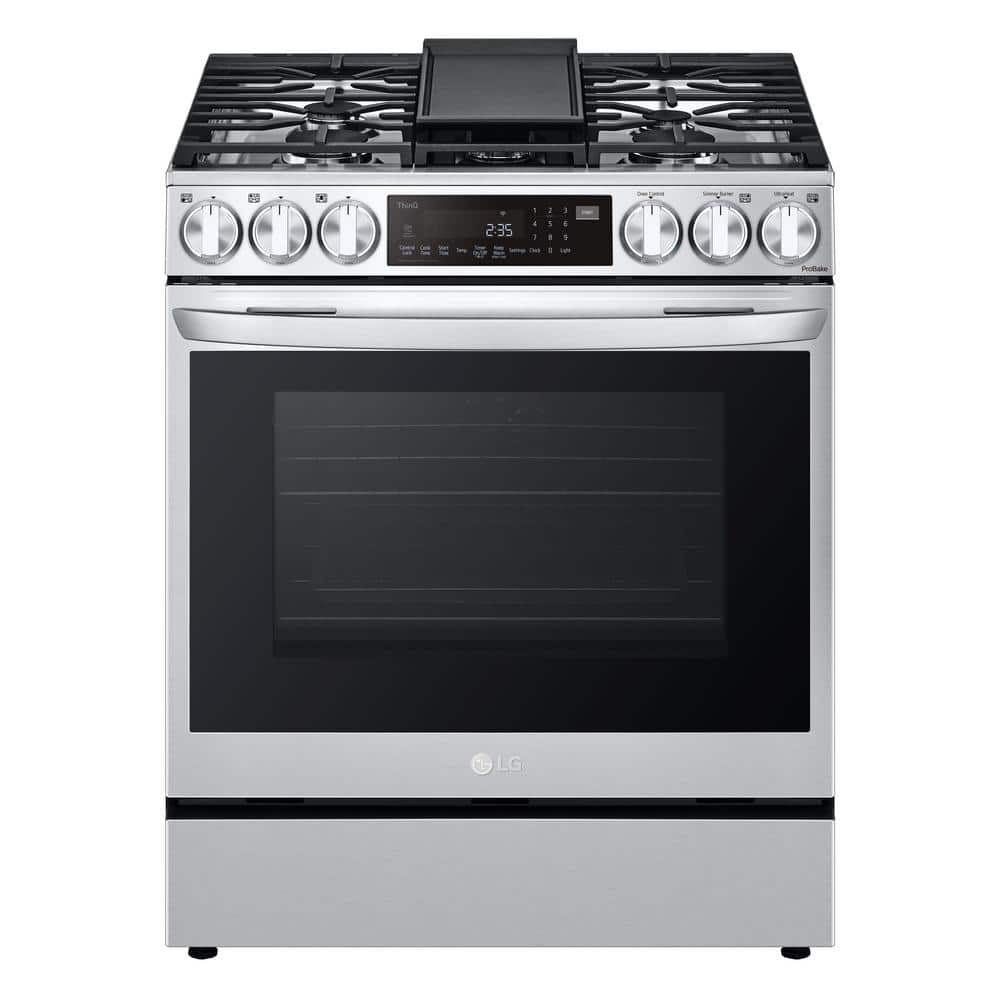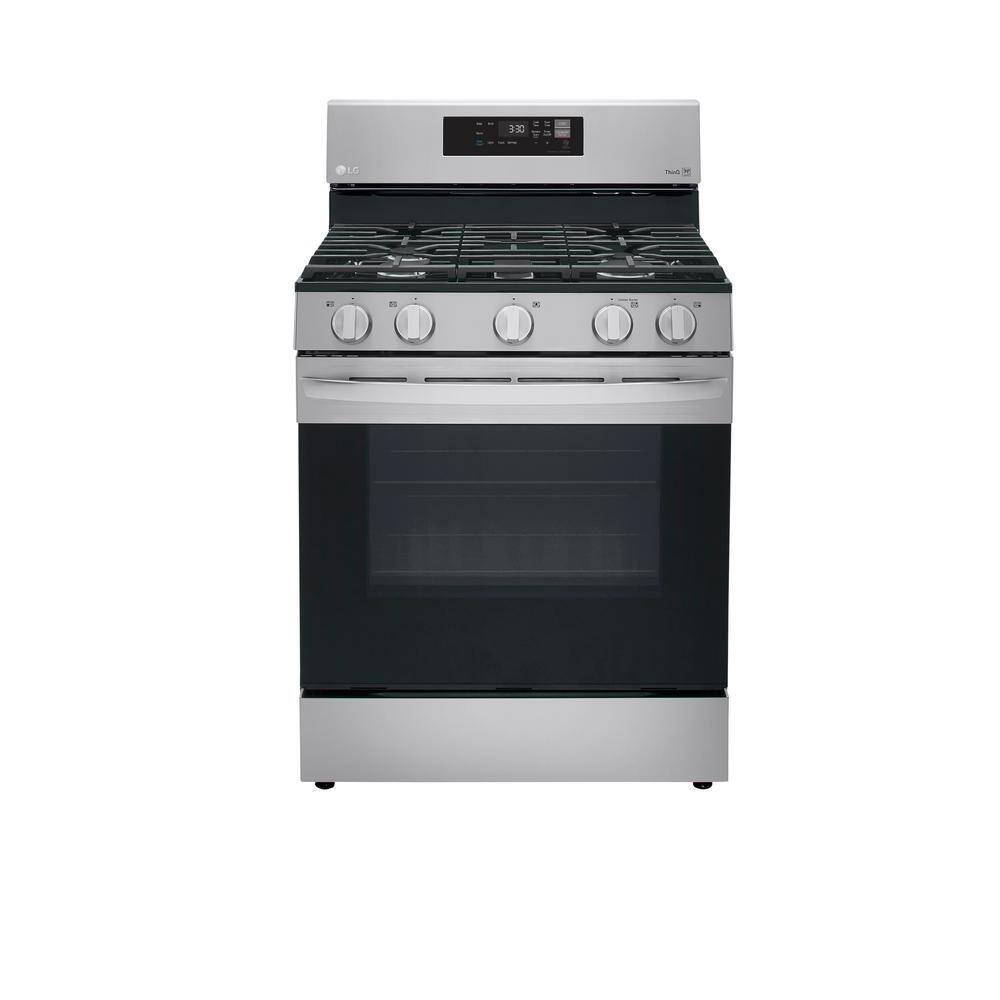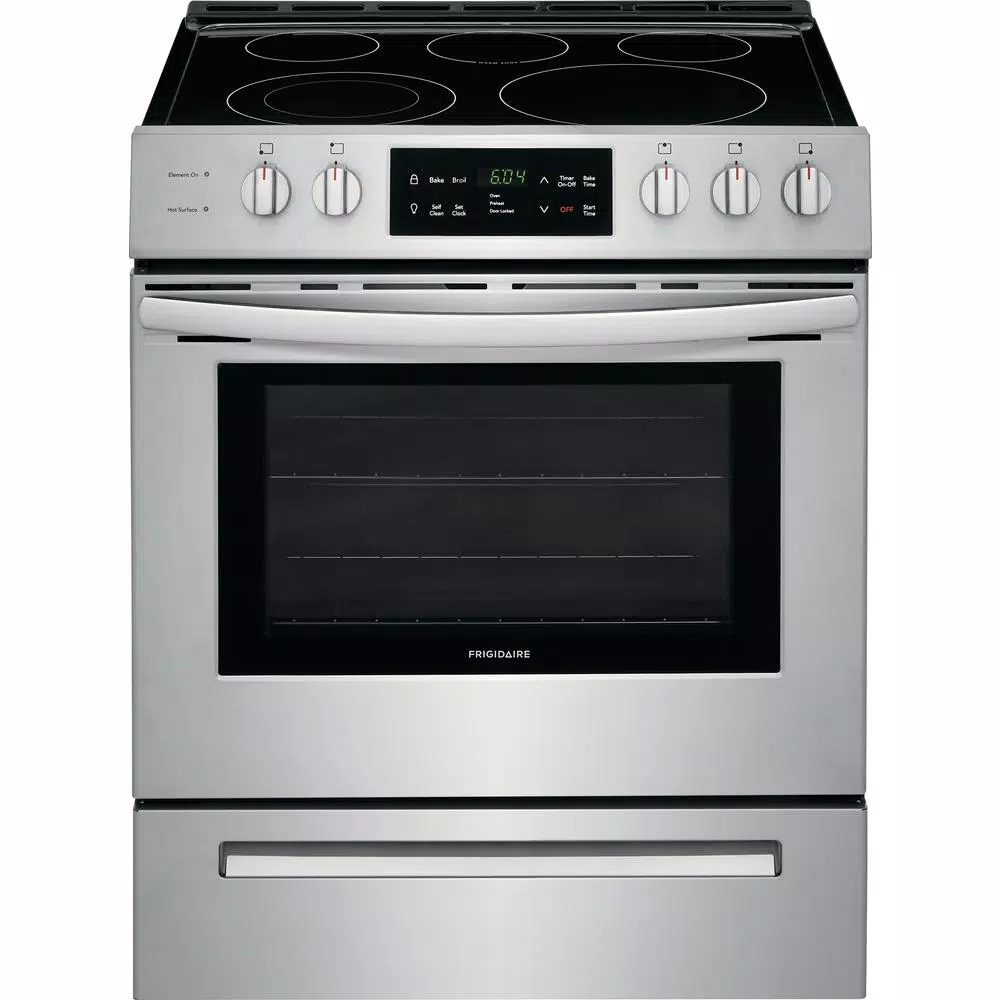Samsung 30 in. 6 cu. ft. Slide-In Gas Range with Smart Dial and Air Fry in Fingerprint Resistant Stainless Steel
-
( 7 Reviews )Rated 4.86 out of 5 based on 7 customer ratings07
Smart Dial learns how you like to cook. Air Fry mode provides healthier cooking with a crunch. Powerful convection saves time cooking food fast and more evenly.
Upgrade any kitchen with this sleek Samsung slide-in gas range. It blends seamlessly with your cabinetry to give your kitchen a high-end look and offers flexibility for big cooking jobs, from its five-burner cooktop to its large-capacity 6 cu. ft. oven. The new Smart Dial simplifies oven settings in a single dial and intuitively learns based on your cooking preferences. Cooking just got healthier with new Air Fry mode. Using little to no oil, you can quickly prepare your favorite fried foods right in your oven. Air Fry tray included. It also features Convection, for beautifully even cooking that takes less time and uses less energy. And with a reversible cast iron griddle and custom wok grate, this slide-in gas range is the perfect range for anyone who loves to cook and entertain.
- Smart Dial simplifies oven settings in a single dial and intuitively learns based on your cooking preferences
- Air Fry uses little to no oil to quickly prepare your favorite fried foods right in your oven
- Air Fry tray included
- Powerful Convection saves you time by cooking food fast and more evenly. Perfect for baking and roasting
- Large 6 cu. ft. Oven Capacity
- Illuminated Knobs
- Fingerprint Resistant Finish
- Reversible Cast-Iron Griddle
- Ready2Fit Guarantee
- Temperature Probe
- Wok Ring
- Wi-Fi Connectivity
- Voice-Enabled
- Convection Auto Conversion
- Self Clean
- Child Safety Lock
- Sabbath Mode
- Also available in Fingerprint Resistant Black Stainless and Tuscan Stainless
Additional information
| Depth With Door(s) Open 90 Degrees (In.) | 25 |
|---|---|
| Oven Interior Depth x Height x Width (in) | 19.6 x 21.6 x 24.8 |
| Product Depth x Height x Width (in) | 28.68 x 37 x 29.9 |
| Range Size | No Certifications or Listings |
| Certifications and Listings | No |
| Manufacturer Warranty | One (1) Year Parts and Labor |
30 may refer to:
- 30 (number), the natural number following 29 and preceding 31
- one of the years 30 BC, AD 30, 1930, 2030
6 (six) is the natural number following 5 and preceding 7. It is a composite number and the smallest perfect number.
A fingerprint is an impression left by the friction ridges of a human finger. The recovery of partial fingerprints from a crime scene is an important method of forensic science. Moisture and grease on a finger result in fingerprints on surfaces such as glass or metal. Deliberate impressions of entire fingerprints can be obtained by ink or other substances transferred from the peaks of friction ridges on the skin to a smooth surface such as paper. Fingerprint records normally contain impressions from the pad on the last joint of fingers and thumbs, though fingerprint cards also typically record portions of lower joint areas of the fingers.
Human fingerprints are detailed, nearly unique, difficult to alter, and durable over the life of an individual, making them suitable as long-term markers of human identity. They may be employed by police or other authorities to identify individuals who wish to conceal their identity, or to identify people who are incapacitated or deceased and thus unable to identify themselves, as in the aftermath of a natural disaster.
Their use as evidence has been challenged by academics, judges and the media. There are no uniform standards for point-counting methods, and academics have argued that the error rate in matching fingerprints has not been adequately studied and that fingerprint evidence has no secure statistical foundation. Research has been conducted into whether experts can objectively focus on feature information in fingerprints without being misled by extraneous information, such as context.
Gas is one of the four fundamental states of matter. The others are solid, liquid, and plasma. A pure gas may be made up of individual atoms (e.g. a noble gas like neon), elemental molecules made from one type of atom (e.g. oxygen), or compound molecules made from a variety of atoms (e.g. carbon dioxide). A gas mixture, such as air, contains a variety of pure gases. What distinguishes gases from liquids and solids is the vast separation of the individual gas particles. This separation usually makes a colorless gas invisible to the human observer.
The gaseous state of matter occurs between the liquid and plasma states, the latter of which provides the upper-temperature boundary for gases. Bounding the lower end of the temperature scale lie degenerative quantum gases which are gaining increasing attention. High-density atomic gases super-cooled to very low temperatures are classified by their statistical behavior as either Bose gases or Fermi gases. For a comprehensive listing of these exotic states of matter, see list of states of matter.
Samsung Group (Korean: 삼성; Hanja: 三星; RR: samseong [samsʌŋ]; stylized as SΛMSUNG) is a South Korean multinational manufacturing conglomerate headquartered in Samsung Digital City, Suwon, South Korea. It comprises numerous affiliated businesses, most of them united under the Samsung brand, and is the largest South Korean chaebol (business conglomerate). As of 2020, Samsung has the eighth-highest global brand value.
Samsung was founded by Lee Byung-chul in 1938 as a trading company. Over the next three decades, the group diversified into areas including food processing, textiles, insurance, securities, and retail. Samsung entered the electronics industry in the late 1960s and the construction and shipbuilding industries in the mid-1970s; these areas would drive its subsequent growth. Following Lee's death in 1987, Samsung was separated into five business groups – Samsung Group, Shinsegae Group, CJ Group and Hansol Group, and JoongAng Group.
Notable Samsung industrial affiliates include Samsung Electronics (the world's largest information technology company, consumer electronics maker and chipmaker measured by 2017 revenues), Samsung Heavy Industries (the world's second largest shipbuilder measured by 2010 revenues), and Samsung Engineering and Samsung C&T Corporation (respectively the world's 13th and 36th largest construction companies). Other notable subsidiaries include Samsung Life Insurance (the world's 14th largest life insurance company), Samsung Everland (operator of Everland Resort, the oldest theme park in South Korea) and Cheil Worldwide (the world's 15th largest advertising agency, as measured by 2012 revenues).
Stainless may refer to:
- Cleanliness, or the quality of being clean
- Stainless steel, a corrosion-resistant metal alloy
- Stainless Games, a British video game developer
- Stainless Broadcasting Company, a TV broadcaster based in Michigan, US
- Stainless Banner, the second national flag of the Confederate States of America
Steel is an alloy of iron and carbon with improved strength and fracture resistance compared to other forms of iron. Because of its high tensile strength and low cost, steel is one of the most commonly manufactured materials in the world. Steel is used in buildings, as concrete reinforcing rods, in bridges, infrastructure, tools, ships, trains, cars, bicycles, machines, electrical appliances, furniture, and weapons.
Iron is always the main element in steel, but many other elements may be present or added. Stainless steels, which are resistant to corrosion and oxidation, typically need an additional 11% chromium.
Iron is the base metal of steel. Depending on the temperature, it can take two crystalline forms (allotropic forms): body-centred cubic and face-centred cubic. The interaction of the allotropes of iron with the alloying elements, primarily carbon, gives steel and cast iron their range of unique properties. In pure iron, the crystal structure has relatively little resistance to the iron atoms slipping past one another, and so pure iron is quite ductile, or soft and easily formed. In steel, small amounts of carbon, other elements, and inclusions within the iron act as hardening agents that prevent the movement of dislocations.
The carbon in typical steel alloys may contribute up to 2.14% of its weight. Varying the amount of carbon and many other alloying elements, as well as controlling their chemical and physical makeup in the final steel (either as solute elements, or as precipitated phases), impedes the movement of the dislocations that make pure iron ductile, and thus controls and enhances its qualities. These qualities include the hardness, quenching behaviour, need for annealing, tempering behaviour, yield strength, and tensile strength of the resulting steel. The increase in steel's strength compared to pure iron is possible only by reducing iron's ductility.
Steel was produced in bloomery furnaces for thousands of years, but its large-scale, industrial use began only after more efficient production methods were devised in the 17th century, with the introduction of the blast furnace and production of crucible steel. This was followed by the Bessemer process in England in the mid-19th century, and then by the open-hearth furnace. With the invention of the Bessemer process, a new era of mass-produced steel began. Mild steel replaced wrought iron. The German states were the major steel producers in Europe in the 19th century. American steel production was centered in Pittsburgh, Bethlehem, Pennsylvania, and Cleveland until the late 20th century.
Further refinements in the process, such as basic oxygen steelmaking (BOS), largely replaced earlier methods by further lowering the cost of production and increasing the quality of the final product. Today more than 1.6 billion tons of steel is produced annually. Modern steel is generally identified by various grades defined by assorted standards organizations. The modern steel industry is one of the largest manufacturing industries in the world, but also one of the most energy and greenhouse gas emission intense industries, contributing 8% of global emissions. However, steel is also very reusable: it is one of the world's most-recycled materials, with a recycling rate of over 60% globally.
With or WITH may refer to:
- With, a preposition in English
- Carl Johannes With (1877–1923), Danish doctor and arachnologist
- With (character), a character in D. N. Angel
- With (novel), a novel by Donald Harrington
- With (album), a 2014 album by TVXQ
- With (EP), a 2021 EP by Nam Woo-hyun






by Arthur
Fit perfectly and looks good. We had to do some extra work due to an issue with building code, but the installers were able to fix it within 24 hours of delivery.
by Tim
I Love this range!
by Rachel
Fair price and a great range overall.
by Antonio
I absolutely love this range!! And I cook ALOT. As always- HD did a great job delivering.
by Kurama
so happy that i have decided to purchase this stove. best stove ever!!
by Breeze
We have only had it about a month and have not yet taken advantage of all of the features, but we love our new Samsung gas range and look forward to many years of use. And it looks impressive as several people have commented when they’ve visited our kitchen. Also, the fingerprint resistant Tuscan stainless steel is a big plus as normal stainless has been a challenge to keep clean.
by Peace
[This review was collected as part of a promotion.] Love this range. The 22,000 btu power burner is a complete game changer, not only for searing and using a wok, but the added power and heat distribution presented with the double burner allows you a lot more control over the pan as well. My only gripe is that the thermometer probe requires you set a temp when the stove will turn off, which means the stove automatically turns off if you remove the probe to place it in another part of the meat, and it meets the heat of the oven.